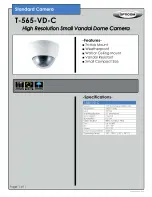
During Commissioning
Where the detector is fitted into
the lid of a control unit, the box lid
may be temporarily held by two of
its fixing screws as shown. This
gives access to the controls during
commissioning. The screws must
be securely tightened to ensure
adequate temporary support.
LRD30 & LRD60
Detector
HORIZONTAL
LRD30 & LRD60
Detector
VERTICAL
LRD-type detectors may be wall
or ceiling mounted.
It is recommended that LR-type
detectors be ceiling mounted.
Where LR-type detectors
cannot be ceiling mounted, the
wall mounting kit (WMK) must
be used.
Polar plot for LRD-type detectors
Free space polar response to ½ step
body movement.
CHOOSING A POSITION
Select a position on a rigid surface where the detector has a clear
view of all the occupants who are expected within the monitored
area.
Face the detector away from glass panels or thin partitions which
have movements occuring behind them (eg trees etc).
The detectors are extremely sensitive to movement; they must be
mounted on a solid surface which has no movement whatsoever.
Extra care must be taken when considering the deployment of
60m detectors in older non-brick buildings which may experience a
degree of movement in strong winds.
Typical mounting height is 3 - 4 metres. Do not mount LR-type
Detectors above 3.5m or LRD-type above 6m without seeking
technical advice.
Often a corner position makes the best use of the detector’s wide
detection pattern.
RANGE AND DETECTION PATTERN ( POLAR PLOT)
DETECTOR
LRD60
LR30 / LRD30
LR15
RANGE
ADJUSTMENT
Up to 60 m
Up to 30 m
Up to 15 m
ELECTRICAL CONNECTIONS
Detectors are supplied with a choice of mountings:
- within the lid of the control unit housing
- in separate housings for remote mounting.
A wall-mounting kit is available for the LR15SM and LR30SM.
If mounted in a separate housing, the detector and its control unit
2
should be interconnected using a minimum 0.75mm mains rated
2-core screened cable - ‘Pyro’ or ‘FP200’ are suggested.
The d.c. voltage measured between terminals B + C at the detector
should not be less than 10 volts.
Three LR-style or two LRD-style detectors may be connected in
parallel to the control unit terminals. See ‘Control Unit Installation
& Commissioning Instructions’ for details.
ORIENTATION OF LRD30 & LRD60 DETECTOR HEADS
Swivel the detector to the best orientation. With the LRD30 and
LRD60, the detector response in its vertical axis is wider than its
horizontal axis, as shown below.
Please Note:
Correct connections are essential for successful operation but
accidentally reversed connections will not damage the detector.
To give the best possible coverage of the area to be controlled, the
head may be adjusted in its eyeball socket to a position best suited to
the shape of the detection area.
The detector head locking screw should be slackened to allow
movement of the detector head. When the correct position has been
established, the head should be locked in position by tightening the
locking screw.
60%
40%
40%
60%
20%
20%
o
70
o
90
o
90
o
70
o
50
80% 100%
OF SET
RANGE
o
50
o
30
o
30
o
10
o
10
RANGE
1
2
3
4
5
6
7
A
B
C
D
E
F
G
A
B
C
SCREENED
LEAD
CONTROL
UNIT
LIGHTSPOT
DETECTOR
DETECTOR HEAD
LOCKING SCREW
(Only on LRD30 &
LRD60 Detectors)
(LRD30 / LRD60 shown)




















